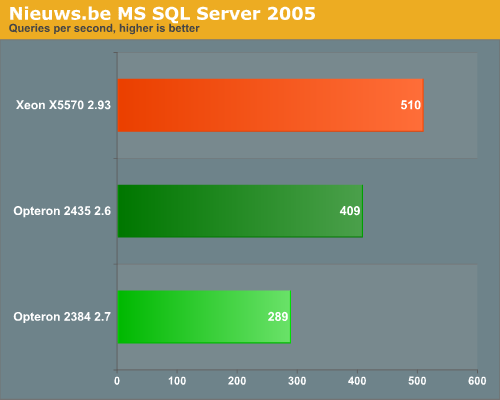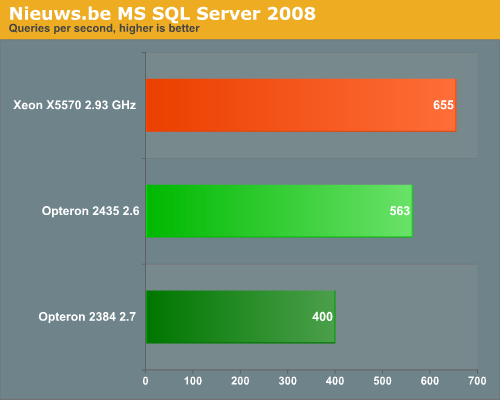Decision Support benchmark: Nieuws.be
Operating System: Windows 2008 Enterprise RTM (64 bit)
Software: SQL Server 2008 Enterprise x64 (64 bit)
Benchmark software: vApus + realworld “Nieuws.be” Database
Database Size: > 100 GB
Typical error margin: 1-2%
The Nieuws.be site is sitting on top of a pretty large database: more than 100 GB and growing. This database consists of a few hundred separate tables, which have been carefully optimized by our lab (the Sizing Servers Lab). We have described our testing methods here in more detail. As some of our readers suggested we upgraded from SQL Server 2005 SP3 to SQL Server 2008. This gave a boost of 29 to 38% (!) to the performance of our decision support database. All configurations use 2 sockets. Take a look at the MS SQL Server 2005 numbers:

And compare with the numbers on SQL Server 2008.

SQL Server 2008 is clearly better optimized for the complex queries that an OLAP database has to absorb.
Back to the hardware. In both cases, you can clearly see that this workload depends less on “uncore” factors (caches, memory bandwidth) than the OLTP test. The Opteron 2435 is a healthy 41% faster than the 2.7 GHz Opteron 2384. A 2.6 GHz quad-core Opteron would score about 385, which means that the scaling from 4 to 6 cores is excellent: 46%. That kind of scaling is very close to the theoretical maximum of 50%, but it is not enough to beat the newest Xeon, which sees its advantage shrink to a 16% lead. However, as the Opteron 2435 competes with 2.66 GHz Xeon and not the Xeon 2.93 GHz, this is the first benchmark where “Istanbul” is competitive. In sharp contrast with the quad-core “Shanghai”, which does not have a chance against the Xeon X55xx armada.










40 Comments
View All Comments
duploxxx - Wednesday, June 3, 2009 - link
ESX 4 should add IOMMU to the AMD istanbul platform, not sure how far this is implemented in the beta esx4 builds.Are you using the paravirtualization scsi driver in the new esx4 platform, I would expect bigegr differences between 3.5 and 4 and not just because EPT is included in esx4 together with enhanced HT.
for the rest very good thorough review.
The only thing I always miss in reviews is that although it is good to test the fastest out there, it is now where near the most deployed platform, you rather should look at the 5520-5530 against 2387 - 2431 as the mid range platform that will be deployed in a wide range of systems, this will have a much healthier performance/price/power platform then the top bin. Even the 5570 is not supported in all OEM platforms for the TDP range.
Adul - Monday, June 1, 2009 - link
I do not see oracle running on top of windows all that often. It is normally running on some *nix OS. How about running the same benchmark on say RHEL instead?InternetGeek - Monday, June 1, 2009 - link
There's actually an odd bug on Oracle's DB that makes it run faster on Windows than on Linux. Search on the internet and you'll find info about it.In the other hand, in my now 9 years in the IT industry I've only come across one Oracle DB running on HP-UX. Everything else (Sybase, MySQL, etc) runs on Windows.
LizVD - Friday, June 5, 2009 - link
Could you provide us with a link for that? I'd like to see if this "bug" corresponds with the behaviour we're seeing on our tests.Nighteye2 - Monday, June 1, 2009 - link
You give a good description of how it works and how it has so much benefit, but then you benchmark only dual-socket servers?It would be fairer to also test and compare octo-socket servers - to see the real impact of that HT assist feature.
phoenix79 - Monday, June 1, 2009 - link
Completely agreed (I was typing up a comment about this too when yours popped up)I'd love to see some 4-way VMWare scores
ltcommanderdata - Monday, June 1, 2009 - link
Yes. Nehalem is in a great position in the DP market, but isn't yet available in MP. It'd be great to see six-core Dunnington and six-core Istanbul go head to head. Conveniently their highest models have similar clock speeds at 2.66GHz and 2.6GHz respectively although Dunnington would be a lot more power hungry and although I don't remember their prices, probably more expensive too.JohanAnandtech - Tuesday, June 2, 2009 - link
Dunnington vs Istanbul coming up ... But we are going to take some time to address the shortcomings of this "deadline" article such as better power consumption readings.solori - Monday, June 1, 2009 - link
"Notice that HT-assist is a performance killer in 2P configurations: you remove two times 1 MB of L3-cache, which is a bad idea with 8 VM’s hitting your two CPUs."BIOS guidance suggests that HT Assist be disabled by default on 2P systems, and enabled only for specialized workloads. So that begs the question: Were vAPUS tests performed with or without HT Assist in the 2P configuration? It was not clear.
I assume AMD-V and RVI were enabled for ALL workloads in ESX 3.5 and 4.0 (forced for 32-bit workloads.) Is this accurate? Based on the number of ESX 3.5 installations out there, this probably should be clearly stated...
I do want to take issue with your memory sizing and estimates on vCPU loading. Let me put it this way: while Nehalem-EP has better memory bandwidth and SMT threads, Opteron has access to abundant memory. Therefore, it does not make sense - for example - to be OK with enabling SMT but then constrain the benchmark to 24GB due to a Xeon memory limitation.
I would urge you to look at 48GB configurations on Xeon and Istanbul for your comparison systems. By the way, in consolidation numbers, this makes a significant reduction in $/VM with only a minor increase in per-system CAPEX.
Another interesting issue you touched on is tuning and load balance. Great job here. These are "black magic" issues that - as you noted - can have serious effects on virtualization performance (ok, scheduling efficiency.) Knowing your platform's balance point(s) is critical to performance sensitive apps but not so critical for light-load virtualization (i.e. not performance sensitive.)
It sounds like your learning - through experimentation with vAPUS - that virtualization testing does not predict similar results from "similarly configured machines" where performance testing is concerned. In fact, the "right balance" of VM's, memory and vCPU/CPU loading for one system may be on the wrong side of the inflection point for another.
All and all, a very good article.
JohanAnandtech - Tuesday, June 2, 2009 - link
"this probably should be clearly stated... "Good suggestion. I adapted the article. RVI and EPT are always on if possible (so also 32 bit). HT-assist is of always on "Auto" (so off) unless we indicate otherwise.
"Therefore, it does not make sense - for example - to be OK with enabling SMT but then constrain the benchmark to 24GB due to a Xeon memory limitation. "
1) You must know that vApus Mark I uses too much memory for the webportals. They can run without any performance loss in 2 GB, even 1 GB. So as we move up on the number of tiles we run, it is best to reclaim the wasted memory.
2) I agree that a price comparison should include copious amount of memory (48 GB or so).
3) We don't have more than 24 GB DDR-3 available right now. It would be unfair to force the system to swap in a performance comparison.
"Opteron has access to abundant memory". What do you mean by this? Typical 2P Opterons have 64 GB, 2P Nehalems 72 GB as upper limit?
"In fact, the "right balance" of VM's, memory and vCPU/CPU loading for one system may be on the wrong side of the inflection point for another"
Great comment. Yes, that makes it even more complex to compare two systems. That is why we decided to show 2 datapoints for the 2 tile systems.
Collin, thanks for the excellent comments. It is very rewarding to notice that people take the time to dissect our hard work. Even if that means that you find wrinkles that we have to iron out. Great feedback.